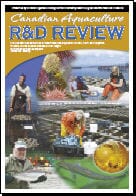
Under the direction of team leaders Dr. Joe Brown and Lynn Lush the Commercialization of Atlantic Cod and Strategies for Improved Hatchery Broodstock Management respectively, are working in tandem to ensure an environmentally and economically viable cod aquaculture industry will soon be up and running.
The Ocean Sciences Centre at Memorial
University received funding from the Atlantic
Canada Opportunities Agency to provide
essential research to enhance the establishment
of a commercial Atlantic cod aquaculture
industry in Newfoundland and to assist in
the continued development of the Atlantic
halibut industry in Atlantic Canada. The
research team works closely with a number
of industry partners including Northern Cod
Ventures Limited, Long Island Resources
and the Newfoundland Aquaculture Industry
Association.
Nearly three years into this project,
the challenges addressed relate to larval
production, weaning, cannibalism and juvenile
growth. Also being investigated are stocking
density, size of entry into sea cages, cage
husbandry, early maturation, fish health and
disease. Research on egg, larval and juvenile
husbandry takes place at the Oceans Sciences
Centre (OSC) while the on-growing takes place
at a demonstration site in Bay dEspoir.
Brown says that the results to date have
been encouraging. We now have a consistent
supply of juveniles with minimal deformity,
says Brown, so in 2004, it was decided that
more attention should be paid to the quality
of juveniles rather than quantity. Experiments
on light intensity, tank bottom color and live
feed enrichments resulted in improved survival
and growth. We found that it is much easier
to manage the fish if the bottom color (of the
tanks) was yellow, said Brown. They hope
to improve on the 20% survival rate to the
juvenile stage by improving egg quality and the
quality of the live feed.
But where we are really lacking is in
cage husbandry, says Brown, things like
stocking densities, grading, vaccinations, early
maturation, feed, and feeding regimes. Feed
is still a major cost we need to know what to
feed and how often. He said that some of their
early studies suggest that restricting feeding to
every second day may be beneficial.
Early studies have shown that juveniles
which are being transferred to sea cages with
an empty gut undergo much less stress.
Brown says there has been much progress
on juvenile health. Studies concentrated on the
use of immunostimulators to combat disease,
comparing wild and cultured cod and the
prevalence of infectious diseases, monitoring
seasonal changes of parasites in the nursery
and cage site, stress and immunological status
of cod at different temperatures and the
efficacy of Parasite-S.
The broodstock management program
is in the final year of a four-year project. Its
research has focused on broodstock husbandry
techniques to optimize egg and larval quality
from controlled spawning of captive fish.
Research is being carried out at the OSC and at
Winterton industrial broodstock facility. Lush
works with more than 300 broodstock, half of
those fish being housed at OSC. We now have
our first domesticated broodstock from the
2001 and the 2002 year classes, says Lush.
The two main objectives of the project
are: to determine the relationships among
broodstock husbandry, feeding schedules,
spawning success and post-spawning mortality
and to develop effective photomanipulation
techniques and assess effects on egg quality,
hatching and the feeding success of larvae.
Lush has divided the broodstock into three
groups, and using photomanipulation has
succeeded in having one group spawn in late
November, (four-month advance), a second
in September (six-month advance) and an
ambient group spawning in late March. Egg
fertilization is excellent averaging 97% and cell
division abnormalities were minimal, averaging
between 3-6% over all batches collected.
Lush says, feeding schedules are
important, another goal is to refine seasonal
feeding regimes for the broodstock. Previously,
it was felt that because cod eat little during
spawning, and that feeding during this
time may reduce egg quality due to fecal
contamination, feeding was halted at this
time. However, Lush says, through research,
they have proven this not to be the case.
We continue feeding throughout the entire
spawning period and our post-spawning
mortality is nil, says Lush. She says fish are fed
to satiation once a week and egg quality and
the health of the broodstock is excellent.
Additional Information
To read the full report, please click here (PDF)
Source: Taken from the website of the British Columbia Salmon Farmers Association - April 2005


